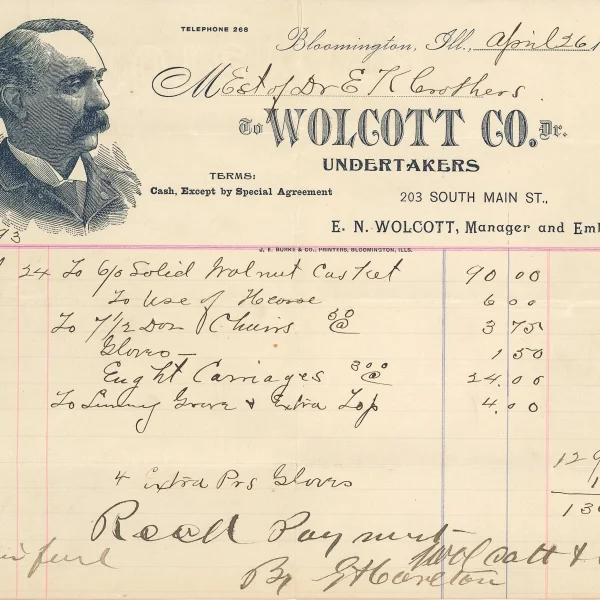As a not-for-profit institution, the McLean County Museum of History depends on the generosity of the public to “grow” its object and archival collections. It is through donations of everything from early settler Isaac Jones’ homespun, hand-stitched denim suit, to Socorro Luna Alvarez’s Seventies-era Mexican bowls, that the museum is able to tell the stories of the past and preserve those yet told by generations to come. It’s a vitally important mission that the museum takes seriously.
Somewhat counterintuitively, it is often seemingly mundane items that speak best to the richness of the past. Take, for instance, this Wolcott Co. invoice dated April 26, 1893. Donated to the museum in 2019 by Bloomington resident David M. Parker, it’s a bill to the estate of Dr. E.K. Crothers itemizing services rendered by the Wolcott undertaking establishment, located on the 200 block of South Main Street in Bloomington, and represented by E.N. Wolcott, manager and embalmer.
The charges included $90 for a solid walnut casket; use of a horse-drawn hearse; chairs for the graveside service; and gloves, presumably for the pallbearers. Adjusting for inflation, the $130.25 bill would be the equivalent of something like $3,750 today.
This document is fascinating in its own right, as it tells us something about the funeral business more than a century ago. Yet of even greater interest are the individuals mentioned therein.
Edwin N. Wolcott was the son of John L. Wolcott, Bloomington’s very first undertaker. The senior Wolcott and his wife Caroline arrived in the city in 1843. Edwin was born the following year, and after serving in the 39th Illinois Infantry Regiment during the Civil War, he followed his father into the undertaking business.
Dr. Eli Kirk (E.K.) Crothers—whose earthly remains resided in Wolcott’s casket— was an early Bloomington physician, In addition to his general medical practice, he operated a drug store and earned a reputation as one of the city’s more capable “occultists” (that is, eye doctor.) It was also Dr. Crothers who commissioned the erection of three adjoining commercial buildings at the corner of Center and Washington streets in downtown Bloomington. These 1855 buildings still stand, with current occupants including Scharnett Associates Architects and Scouts Downtown Cafe.
Crothers’ wife, Marie Louise DePew Crothers, is generally believed to be Bloomington’s first female physician. “The Doctor Crothers” (as the husband and wife were sometimes called) featured E.K. specializing in “diseases of the eye and ear,” while Louise (she preferred her middle name) kept an office at the family home, treating women and children, and practicing obstetrics and gynecology.
Their daughter Rachel eventually left Bloomington for the Great White Way to become one the leading American dramatists of the 1920s. Rachael Crothers enjoyed sustained success on the Broadway stage—writing and producing a series of sophisticated plays highlighting the patriarchal obstacles and double standards women faced in a rapidly modernizing nation.
Scholars of Abraham Lincoln may care not a whit about Rachel Crothers or gender politics of the Jazz Age, but they surely know the name E.K. Crothers. And just why is that? Well, the good doctor was once Lincoln’s client in the medical malpractice suit, Fleming vs. Rogers & Crothers, better known by its informal name—the “Chicken Bone Case.”
At issue was the claim by local carpenter Thomas P. Fleming that Crothers and Dr. Thomas P. Rogers improperly set his broken right leg, saddling him with a lifelong limp. Lincoln, in his spring 1857 summation to the McLean County Circuit Court jury, used two chicken-leg bones—one from an adult chicken and the other from a juvenile—to demonstrate the brittleness of the former vis-à-vis the latter.
In so many words, Lincoln told the jury that given the severity of Fleming’s injuries and the fragility of his bones (he was, after all, a middle-aged man at the time), the plaintiff, rather than suing Rogers and Crothers, should be thankful to still have a right leg to complain about! After eighteen hours of deliberation, the jury failed to reach a decision. In the end, the case was settled out of court before the spring 1858 session.
Who knew there was so much to learn from one old invoice!

